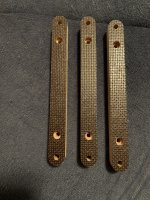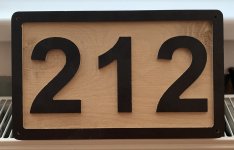I used a similar CNC to learn. And then I bought a different one with a large steel frame for my speaker projects. Now the old one is waiting for an expansion kit to make it 30 x 40 cm working area and put a laser on it. I used 1/8" single flute upcut bit and plywood machined pretty fine.
Attachments
Yes, this is a deluxe version, all metal construction, larger diameter bearings and sliding rods and a better spindle as well. I have an improved Z axis as well with a longer travel, it will be mounted with the upgrade. I also need to add homing switches and a box around it. But since I have my larger CNC (ca 82 x 82 cm working area), I spend most of my hobby time with it.
Do you mean without a positional sensor? Surely a laser range finder would work?I know somebody who built wire EDM machines from different bits, saved a lot of money.
PLCs and drive motors are cheap, $300 and up for basic PLCs.
If you look at it, the base, drive, guides, and controllers are basically made by different people.
Laser levels might work for checking, redoing the alignment is difficult.
Sell the machine , or use it for low resolution work.
Worn ball screws will also cause errors, the tool will never return to the same position for the next cut.
Lasers are not preferred. Some safety issues.
Linear potentiometers / encoders / geared encoders / ultrasound based sensors are encountered, depends on task and accuracy.
Also ease of availability, price, and quality during service.
Linear potentiometers / encoders / geared encoders / ultrasound based sensors are encountered, depends on task and accuracy.
Also ease of availability, price, and quality during service.
There’s a lot of precision encoders out there but they’re the cost of the DIYer CNC each! I looked at absolute rotary encoders for telescope positioning, they get you close but time stepping below pixel arc second resolution was the final precision answer.Lasers are not preferred. Some safety issues.
Linear potentiometers / encoders / geared encoders / ultrasound based sensors are encountered, depends on task and accuracy.
Also ease of availability, price, and quality during service.
A laser ranger would work with class standards can be used by the average home owner and that could be embedded into the machine actuator. If you want a really precise you could use optical interferometry and even use it to measure the flatness of the work using polarised light.
Normal CNC machines on the shop floor are good to 5 or 3 microns repeat accuracy for most purposes.
I think the type of units you are describing are much more precise, and not used in mass produced machines at this time.
For a trainer machine, or plastic molds, a rigid machine, with 5 micron accuracy is good enough, the hydraulics must be good.
Space telescopes are not common here, and you are describing some sort of remote controlled unit, I think.
But optical flat resolution machining is rarely needed, in my experience.
I mold plastics, optical grade if needed, metal machining is not my area of expertise.
The unit in post #22 is a very basic unit, not very sturdy or durable.
I think the type of units you are describing are much more precise, and not used in mass produced machines at this time.
For a trainer machine, or plastic molds, a rigid machine, with 5 micron accuracy is good enough, the hydraulics must be good.
Space telescopes are not common here, and you are describing some sort of remote controlled unit, I think.
But optical flat resolution machining is rarely needed, in my experience.
I mold plastics, optical grade if needed, metal machining is not my area of expertise.
The unit in post #22 is a very basic unit, not very sturdy or durable.
- Home
- Design & Build
- Equipment & Tools
- 3 axis CNC and PCBs



